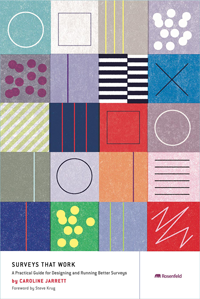
You get a good survey by doing many things well
My book on surveys Surveys That Work: a practical guide for designing and running better surveys takes you through a seven-step process for creating and running an effective survey. You can read a sample chapter here: Surveys That Work: An excerpt from Chapter 1.
The aim is to get valid results
Total Survey Error is the term survey methodologists use to describe the problems that can arise at each of the seven stages. I created a survey octopus to show how all of the errors are connected. By understanding the issues and making good choices at every step you’ll get solid results to help you make decisions.
The links below will help you if you are just getting started on surveys:
- A quick introduction: Five steps to better surveys – this presentation forms part of a one-day workshop for non-specialists.
- For rigorous results and to avoid survey error: Surveys that work at LibDesign 2016 – this presentation offers a more complete, seven step, survey process, as well as an introduction to avoiding survey error.
- The least you can do to improve a survey: downloadable resources from chapter 8 of my survey book.
I can help you to make your surveys more effective
Better surveys start with improving the user experience so you get better response rates and better quality data. I can support you with:
- identifying whether a survey is the right approach;
- writing good questions that users can understand and answer;
- building and designing the questionnaire;
- testing the survey;
- turning raw data into valuable insight;
- tailored staff training courses.
. Read more about the ways in which we can work together:
